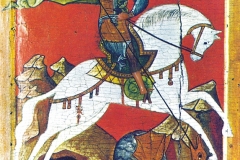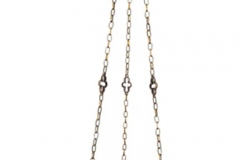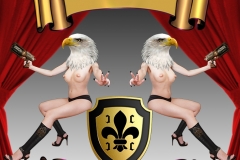About national identity
About national identity
Seven Icons
“Seven Icons” is an installation where seven icons are arranged under a cresset and each of them represents one mortal sin. This work is not a critique of religion, but of the church as an institution that, in the name of faith, committed terrible crimes throughout history. False morality, whether it is a rich and powerful Catholic church that preaches modesty or debauchery of priests while preaching chastity, is presented through the characters of plastic dolls, Ken and Barbie instead of the characters of Christ, the Mother of God and saints.
Great Blessed Serbia
“Great Blessed Serbia” is a work that parodies issues related to nationalism and the glorification of Serbs. “Pieta” represents the Mother of God with a dead Chetnik (1. A Serbian nationalist belonging to a group that fought against the Turks before World War I and engaged in guerrilla warfare during both World Wars, 2. A member of a Serbian nationalist paramilitary group fighting or campaigning to retain Serbian influence in the countries which formerly constituted Yugoslavia), “Serbia to Tokyo” instead of a dove with an olive branch of peace, has an eagle with a poppy flower, and “With faith in God” vividly shows the false morality of both the church and its believers. With this work, patriotism is not the subject of ridicule. “Greater Blessed Serbia” criticizes xenophobia, violence and crime.
Turbo folk Apologia
Turbo folk Apologia, 19′ 5”, 2009
This video has a form of a TV show from the parallel universe called Planet’s Trend, and the episode carries an ironic name ‘’Turbo folk Apologia’’. The TV presenter, who, subjected to various plastic surgeries and no longer able to have the facial expressions, on one hand mimics the appearance of a turbo folk star, while on the other, is quoting Baudrillard. In this work, in 2008, scientists from CERN mistakenly had created a black hole through which the Earth has passed and appeared in the parallel universe, next to the planet almost identical to ours, albeit with difference in some historical events. There, neither the war in Yugoslavia, nor turbo folk has happened. Our Earth has remained without sentient beings, only with artefacts as the residuals of the missing civilization. In the attempt to reconstruct the historical and cultural development, the beings from another planet have come to the wrong conclusion that turbo folk, as an important cultural phenomenon, represents the climax of postmodern art.
The work is also an allusion to the evaluation of cultural heritage, norms, making judgments, as well as the expansion of certain information and views with public. The undisputed influence of turbo folk to the whole generation that grew up in the 90s in Serbia, even to those who have built their identity opposing it, is visible and recognizable, at the visual or aesthetic level, as well as the political, i.e. national: turbo folk had exclusive right to the appearance in the media while the rest were pushed to the margins.
This project is not only a personal story, it is global and as well as local, “glocal“. As things are much more drastic and transparent in totalitarian regimes, thus turbo folk reflects the state of affairs in a broader aspect. This narrative emphasizes the story where authorities create cultural paradigms, but also reflect the Western empire image in a distorted mirror. Turbo folk, as a bare form of capitalist society, is also its mutated product.











